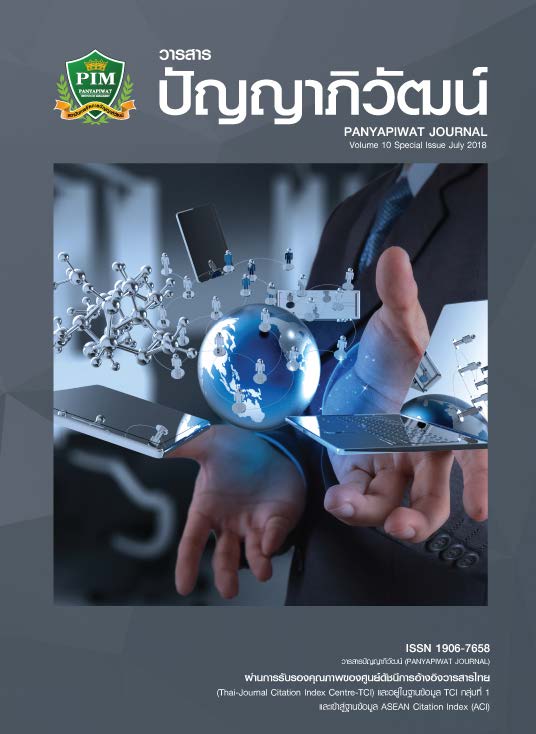เทคนิคการแปลผลการวิเคราะห์องค์ประกอบสำหรับงานวิจัย
Main Article Content
บทคัดย่อ
การวิเคราะห์องค์ประกอบเป็นเทคนิคการวิเคราะห์ทางสถิติที่ใช้ลดจำนวนตัวแปรหลายๆ ตัวในการศึกษา ด้วยการรวมกลุ่มตัวแปรที่มีความสัมพันธ์กันไว้เข้าด้วยกัน โดยต้องมีความสัมพันธ์กันในระดับมากซึ่งอาจจะอยู่ในทิศทางเดียวกัน (ทิศทางเป็นบวก) หรืออยู่ในทิศทางตรงกันข้าม (ทิศทางเป็นลบ) ก็ได้ ส่วนตัวแปรที่อยู่คนละองค์ประกอบจะไม่มีความสัมพันธ์กันหรือมีความสัมพันธ์กันน้อยมาก โดยมีข้อตกลงเบื้องต้น ได้แก่ จำนวนตัวแปรที่คัดเลือกมาวิเคราะห์องค์ประกอบควรมีจำนวนมากกว่า 30 ตัวแปร และกลุ่มตัวอย่างที่ใช้ควรมากกว่าจำนวนตัวแปรอย่างน้อย 5-10 เท่า การใช้สถิตินี้ทำให้นักวิจัยสามารถอธิบายความหมายของแต่ละองค์ประกอบด้วยตัวแปรที่เกี่ยวข้องได้ง่ายขึ้น รวมทั้งมีความถูกต้องและน่าเชื่อถือมากขึ้น
Article Details
“ข้าพเจ้าและผู้เขียนร่วม (ถ้ามี) ขอรับรองว่า บทความที่เสนอมานี้ยังไม่เคยได้รับการตีพิมพ์และไม่ได้อยู่ระหว่างกระบวนการพิจารณาลงตีพิมพ์ในวารสารหรือแหล่งเผยแพร่อื่นใด ข้าพเจ้าและผู้เขียนร่วมยอมรับหลักเกณฑ์การพิจารณาต้นฉบับ ทั้งยินยอมให้กองบรรณาธิการมีสิทธิ์พิจารณาและตรวจแก้ต้นฉบับได้ตามที่เห็นสมควร พร้อมนี้ขอมอบลิขสิทธิ์บทความที่ได้รับการตีพิมพ์ให้แก่สถาบันการจัดการปัญญาภิวัฒน์หากมีการฟ้องร้องเรื่องการละเมิดลิขสิทธิ์เกี่ยวกับภาพ กราฟ ข้อความส่วนใดส่วนหนึ่งและ/หรือข้อคิดเห็นที่ปรากฏในบทความข้าพเจ้าและผู้เขียนร่วมยินยอมรับผิดชอบแต่เพียงฝ่ายเดียว”
เอกสารอ้างอิง
Burns, N. & Grove, S. K. (1993). The practice of nursing research: conduct, critique, & utilization (4th ed.).Philadephia: W.B. Saunders company.
Byrne, B. M. (2001). Structural equation modeling with AMOS: basic concepts, applications, and programming.NJ: Lawrence Erlbaum Associates.
Joreskog, K. G. & Sorbom, D. (1989). LISREL 8: A Guide to the Program SPSS. Chicago: SPSS.
Kerlinger, F. N. (1986). Foundations of Behavioral Research (3rd ed.). USA: Hort, Rinehart and Winson.
Pinyo, T. (2013). Component Analysis of the Needs of Entrepreneurs towards the Bachelor of Science. Faculty of Science and Technology, Suan Sunandha Rajabhat University. [in Thai]
Rangsungnoen, G. (2011). Factor analysis by SPSS and AMOS for Research. Bangkok: Se-Education. [in Thai]
Singchongchai, P. (2006). Principles and Using of Multivariate Statistical Analysis for Nursing Research. Songkla: Chanmuang Press. [in Thai]
Stevens, J. (1992). Applied multivariate statistics for the social sciences (2nd ed.).Mahwah, NJ: Lawrence Erlbaum Associates.
Stevens, J. (1996). Applied multivariate statistics for the social sciences (3rd ed.).Mahwah, NJ: Lawrence Erlbaum Associates.
Tabachnick, B. G. & Fidell, L. S. (2001). Using multivariate statistics. Boston: Allyn and Bacon.
Vanichbuncha, K. (2017). Advanced Statistical Analysis by SPSS for Windows. Bangkok: Chulalongkorn University Book Center. [in Thai]
Wangsin, N. (2010). The Causal Relationship of Variables Affecting Teaching- learning Behaviors of Teachers at Yasothon Educational Area District Office 1: Route Analysis. Thesis, Master of Education, Graduate School, Ubon Ratchathani Rajabhat University. [in Thai]
Watpon.com. (n.d). Factor Analysis.Retrieved August 20, 2017, from www.watpon.in.th/spss23/spss11.pdfName and Surname: Terada PinyoHighest Education: M.Ed. (Educational Research), Chulalongkorn UniversityUniversity or Agency: Panyapiwat Institute of ManagementFields of Expertise: Applied Statistics, ResearchAddress: 85/1 Moo 2, Chaengwattana Rd., Bang Talad, Pakkred, Nonthaburi 11120


